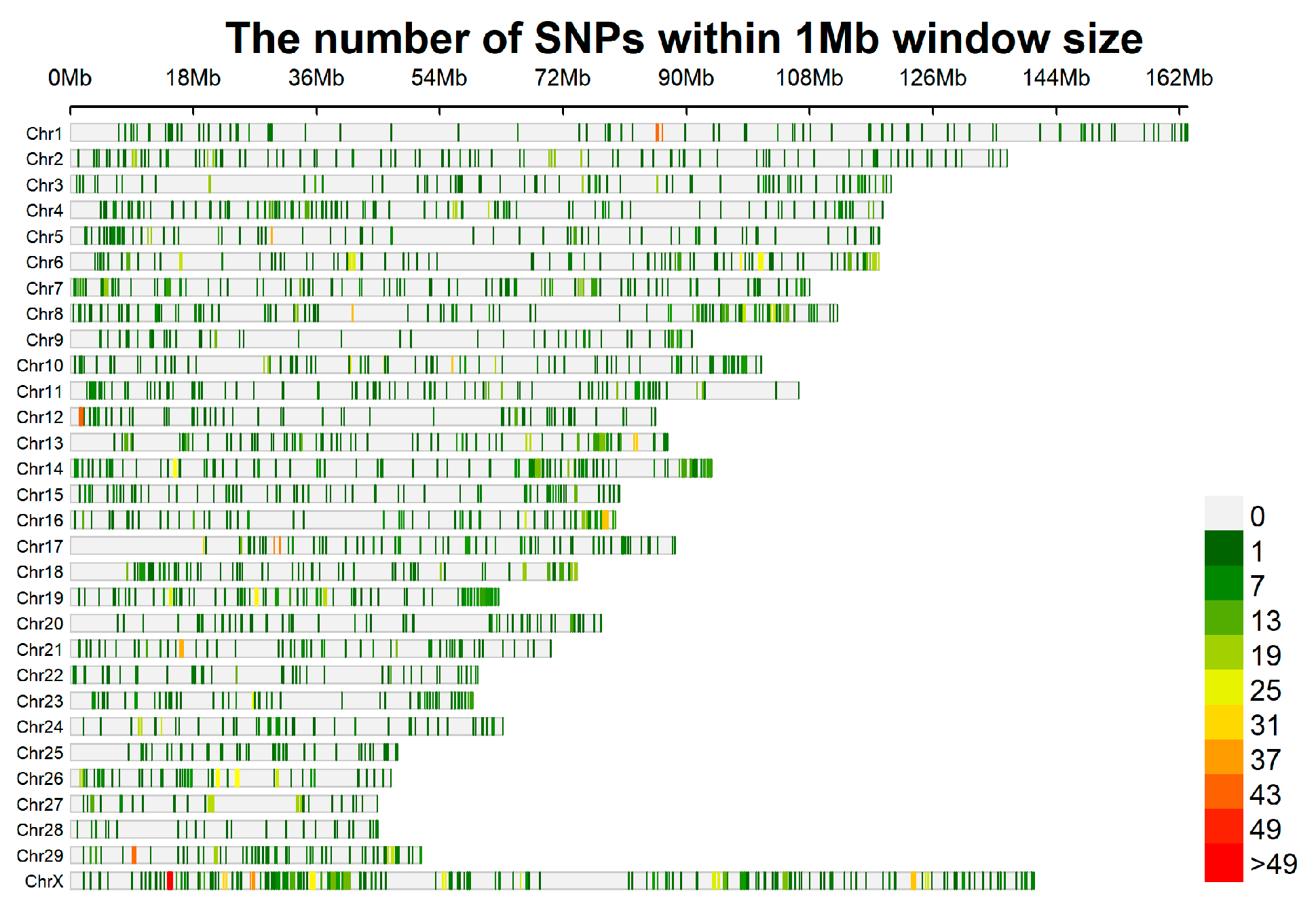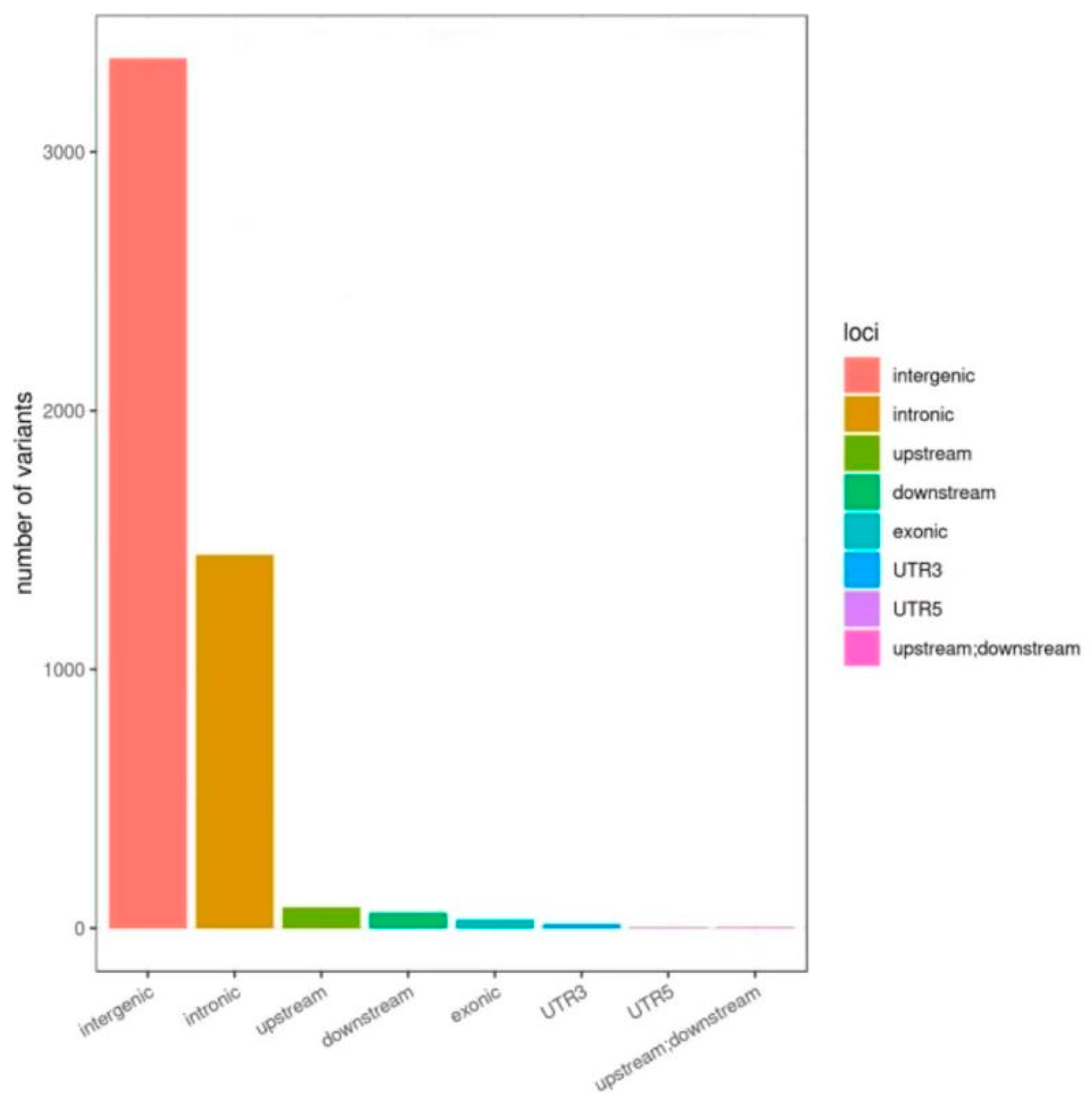Development and Validation of a 5K Liquid Chip for Identifying Cashmere Goat Populations in Inner Mongolia Autonomous Region
Simple Summary
Abstract
1. Introduction
2. Materials and Methods
2.1. Data Collection and SNP Calling
2.2. Probe Design and Selection of Specific SNP Sites
3. Validation of 5K Liquid Chip
3.1. DNA Collection and Library Construction
3.2. Sequencing, Quality Control, and Variant Detection
3.3. Principal Component Analysis and Phylogenetic Tree Construction
4. Results
4.1. Determination of Specific SNP Sites in the Five Cashmere Goat Breeds
4.2. The Distribution of SNP Sites on Chromosomes for the 5K Liquid Chip
4.3. Annotation of SNPs in the 5K Liquid Chip
4.4. Validation of the 5K Liquid Chip for Identification of Five Cashmere Goat Populations
4.5. Principal Component Analysis and Phylogenetic Tree Construction
5. Discussion
6. Conclusions
Supplementary Materials
Author Contributions
Funding
Institutional Review Board Statement
Informed Consent Statement
Data Availability Statement
Conflicts of Interest
References
- Froghi, T.; Hosaini, A. Origin and domestication of the goat and history of the Angora goat and the mohair industry. Life Sci. J. 2012, 9, 2615–2618. [Google Scholar]
- Panth, B.P.; Bhattarai, N.; Baral, P.; Karki, M.; Bhattarai, A.; Sapkota, S. Factors affecting the profitability from goat farming in Gulmi, Nepal. Cogent Food Agric. 2021, 7, 1963928. [Google Scholar] [CrossRef]
- Horst, P. Animal breeding as a factor of influence on the conservation of natural resources and utilisation of genetic resources. Anim. Res. Dev. 1997, 46, 63–74. [Google Scholar] [CrossRef]
- Salako, A.E. Application of Morphological Indices in the Assessment of Type and Function in Sheep. Int. J. Morphol. 2006, 24, 13–18. [Google Scholar] [CrossRef]
- Ouyang, J.; Wang, L. The Progress and Application of DNA Barcoding in Genetic Resources Conservation for Local Pig. J. Agric. Biotechnol. 2013, 21, 348–354. [Google Scholar]
- Ashoor, S.H.; Monte, W.C.; Stiles, P.G. Liquid chromatographic identification of meats. J. Assoc. Off. Anal. Chem. 1988, 71, 397–403. [Google Scholar] [CrossRef]
- Dalvit, C.; De Marchi, M.; Targhetta, C.; Gervaso, M.; Cassandro, M. Genetic traceability of meat using microsatellite markers. Food Res. Int. 2008, 41, 301–307. [Google Scholar] [CrossRef]
- Weller, J.I.; Seroussi, E.; Ron, M. Estimation of the number of genetic markers required for individual animal identification accounting for genotyping errors. Anim. Genet. 2010, 37, 387–389. [Google Scholar] [CrossRef] [PubMed]
- Negrini, R.; Milanesi, E.; Colli, L.; Pellecchia, M.; Nicoloso, L.; Crepaldi, P.; Lenstra, J.A.; Ajmone-Marsan, P. Breed assignment of Italian cattle using biallelic AFLP markers. Anim. Genet. 2010, 38, 147–153. [Google Scholar] [CrossRef]
- Weir, B.S.; Cardon, L.R.; Anderson, A.D.; Nielsen, D.M.; Hill, W.G. Measures of human population structure show heterogeneity among genomic regions. Genome Res. 2005, 15, 1468–1476. [Google Scholar] [CrossRef]
- Paschou, P.; Ziv, E.; Burchard, E.G.; Choudhry, S.; Rodriguez-Cintron, W.; Mahoney, M.W.; Drineas, P. PCA-Correlated SNPs for Structure Identification in Worldwide Human Populations. PLoS Genet. 2007, 3, 1672–1686. [Google Scholar] [CrossRef] [PubMed]
- Li, W.; Yang, L.; Ren, Y.; Yan, X.; Wang, J. Quantification of rib COL1A2 gene expression in healthy and fluorosed Inner Mongolia cashmere goats. Fluoride 2022, 40, 13–18. [Google Scholar]
- Wang, R.; Wang, X.; Qi, Y.; Li, Y.; Na, Q.; Yuan, H.; Rong, Y.; Ao, X.; Guo, F.; Zhang, L.; et al. Genetic diversity analysis of Inner Mongolia cashmere goats (Erlangshan subtype) based on whole genome re-sequencing. BMC Genom. 2024, 25, 698. [Google Scholar] [CrossRef]
- Zhao, Q.; Huang, Y.; Chen, Q.; Su, Y.; Zhang, Y.; Wang, R.; Su, R.; Xu, H.; Liu, S.; Ma, Y.; et al. Genomic Inbreeding and Runs of Homozygosity Analysis of Cashmere Goat. Animals 2024, 14, 1246. [Google Scholar] [CrossRef]
- Zhang, T.; Wang, Z.; Zhang, Y. Genetic diversity and population structure in five Inner Mongolia cashmere goat populations using whole-genome genotyping. Anim. Biosci. 2024, 37, 1168–1176. [Google Scholar] [CrossRef] [PubMed]
- Danecek, P.; Auton, A.; Abecasis, G.; Albers, C.A.; Banks, E.; DePristo, M.A.; Handsaker, R.E.; Lunter, G.; Marth, G.T.; Sherry, S.T.; et al. The variant call format and VCFtools. Bioinformatics 2011, 27, 2156–2158. [Google Scholar] [CrossRef]
- Wang, K.; Li, M.; Hakonarson, H. ANNOVAR: Functional annotation of genetic variants from high-throughput sequencing data. Nucleic Acids Res. 2010, 38, e164. [Google Scholar] [CrossRef]
- Shelkovnikov, A.B. Application of the software for BWA systems for analysis and design. In Proceedings of the 12th International Conference Microwave and Telecommunication Technology, Sevastopol, Ukraine, 9–13 September 2002; IEEE: Piscataway, NJ, USA, 2002. [Google Scholar]
- Tucci, N.; Cala, J.; Steyn, J.; Missier, P. Design and evaluation of a genomics variant analysis pipeline using GATK Spark tools. In Proceedings of the 26th Italian Symposium in Advanced Database Systems (SEBD 2018), Taranto, Italy, 24–27 June 2018. [Google Scholar]
- Yang, J.; Lee, S.H.; Goddard, M.E.; Visscher, P.M. Genome-Wide Complex Trait Analysis (GCTA): Methods, Data Analyses, and Interpretations. Methods Mol. Biol. 2013, 1019, 215–236. [Google Scholar]
- José, C.; Jesús, P.; Alberto, F. Data understanding with PCA: Structural and Variance Information plots. Chemom. Intell. Lab. Syst. 2010, 100, 48–56. [Google Scholar]
- Zhang, C.; Chen, X.; Cao, B.; Duan, H.; Sun, Q.; Ouyang, F. Tuning the band gap of the InSe monolayer by substitutional doping. Appl. Surf. Sci. 2022, 579, 152190. [Google Scholar] [CrossRef]
- Niu, A.; Zhang, X.; Yang, Y.; Yan, Z.; Gong, H.; Ding, R.; Ma, L. Identification of Variety Composition of Large White Pig, Changbai Pig, and Duroc Pig Based on SNP Chip Analysis. Chin. J. Anim. Husb. 2022, 58, 219–223. [Google Scholar]
- Min, B.R.; Han, J.Y.; Lee, M.H. The identification of beef breeds (Korean cattle beef, Holstein beef and Imported beef) using random amplified polymorphic DNAs. Korean J. Anim. Sci. 1995, 37, 651–660. [Google Scholar]
- Miao, J.; Chen, Z.; Zhang, Z.; Wang, Z.; Wang, Q.; Zhang, Z.; Pan, Y. A web tool for the global identification of pig breeds. Genet. Sel. Evol. 2023, 55, 18. [Google Scholar] [CrossRef]
- Tosserklopp, G.; Bardou, P.; Bouchez, O.; Cabau, C.; Crooijmans, R.; Dong, Y.; Donnadieu-Tonon, C.; Eggen, A.; Heuven, H.C.; Jamli, S.; et al. International Goat Genome Consortium Design and Characterization of a 52K SNP Chip for Goats. PLoS ONE 2014, 9, e86227. [Google Scholar]
- Qiao, X.; Su, R.; Wang, Y.; Wang, R.; Yang, T.; Li, X.; Chen, W.; He, S.; Jiang, Y.; Xu, Q.; et al. Genome-wide Target Enrichment-aided Chip Design: A 66K SNP Chip for Cashmere Goat. Sci. Rep. 2017, 7, 8621. [Google Scholar] [CrossRef]
- Wang, F. Design of SNP Chip for Goats and Genome-Wide Association Analysis and Genome Selection Study of Important Economic Traits in Inner Mongolia Cashmere Goats. Ph.D. Thesis, Inner Mongolia Agricultural University, Hohhot, China, 2021. [Google Scholar]
- Wang, Y.; Wang, J.; Liu, X.; Zhao, L.; Yang, S. Identification of Yellow River carp based on SNP markers. J. Aquac. 2022, 35, 7–14. [Google Scholar]
- Ramos, A.M.; Crooijmans, R.; Affara, N.A.; Amaral, A.G.; Archibald, A.L.; Beever, J.E.; Bendixen, C.; Churcher, C.; Clark, R.; Dehais, P.; et al. Design of a High Density SNP Genotyping Assay in the Pig Using SNPs Identified and Characterized by Next Generation Sequencing Technology. Public Libr. Sci. 2009, 4, e6524. [Google Scholar] [CrossRef]





| Name | Sex | No. | Stock |
|---|---|---|---|
| ARBS | female | 56 | Inner Mongolia Yiwei White Cashmere Goat Co., Ltd. (Ordos, China) |
| ELS | female | 57 | Inner Mongolia Mizhen International Trade Co., Ltd. (Bayannaoer, China) |
| ALS | female | 54 | Alxa Left Banner Goat Breeding Farm |
| HS | female | 56 | Chifeng Bahrain Right Banner Hanshan Goat Breeding Farm |
| WZMQ | female | 58 | Ujimqin White Goat Original breeding Farm |
| Population | Number of Missing Sites | Missing Rate | Number of Heterozygous Sites | Heterozygous Mutation Rate | Number of Homozygous Sites | Homozygous Mutation Rate | Consistent Number of Sites | Site Consistency Rate |
|---|---|---|---|---|---|---|---|---|
| ARBAS | 12 | 0.25 | 1954 | 39.16 | 968 | 19.40 | 2068 | 41.45 |
| ELS | 12 | 0.24 | 2095 | 41.97 | 1044 | 20.92 | 1851 | 37.10 |
| ALS | 12 | 0.25 | 1938 | 38.85 | 974 | 19.52 | 2077 | 41.63 |
| HS | 11 | 0.23 | 1815 | 36.36 | 1937 | 38.81 | 1239 | 24.83 |
| WZMQ | 11 | 0.21 | 2022 | 40.51 | 1592 | 31.89 | 1378 | 27.60 |
| Mean | 12 | 0.23 | 1965 | 39.37 | 1303 | 26.11 | 1723 | 34.52 |
Disclaimer/Publisher’s Note: The statements, opinions and data contained in all publications are solely those of the individual author(s) and contributor(s) and not of MDPI and/or the editor(s). MDPI and/or the editor(s) disclaim responsibility for any injury to people or property resulting from any ideas, methods, instructions or products referred to in the content. |
© 2024 by the authors. Licensee MDPI, Basel, Switzerland. This article is an open access article distributed under the terms and conditions of the Creative Commons Attribution (CC BY) license (https://creativecommons.org/licenses/by/4.0/).
Share and Cite
Zhang, T.; Xu, Q.; Zhou, B.; Xiao, J.; Zheng, S.; Li, J.; Lv, Q.; Zhang, Y.; Wang, R.; Su, R.; et al. Development and Validation of a 5K Liquid Chip for Identifying Cashmere Goat Populations in Inner Mongolia Autonomous Region. Animals 2024, 14, 3589. https://doi.org/10.3390/ani14243589
Zhang T, Xu Q, Zhou B, Xiao J, Zheng S, Li J, Lv Q, Zhang Y, Wang R, Su R, et al. Development and Validation of a 5K Liquid Chip for Identifying Cashmere Goat Populations in Inner Mongolia Autonomous Region. Animals. 2024; 14(24):3589. https://doi.org/10.3390/ani14243589
Chicago/Turabian StyleZhang, Tao, Qi Xu, Bohan Zhou, Junjie Xiao, Shudan Zheng, Jinquan Li, Qi Lv, Yanjun Zhang, Ruijun Wang, Rui Su, and et al. 2024. "Development and Validation of a 5K Liquid Chip for Identifying Cashmere Goat Populations in Inner Mongolia Autonomous Region" Animals 14, no. 24: 3589. https://doi.org/10.3390/ani14243589
APA StyleZhang, T., Xu, Q., Zhou, B., Xiao, J., Zheng, S., Li, J., Lv, Q., Zhang, Y., Wang, R., Su, R., & Wang, Z. (2024). Development and Validation of a 5K Liquid Chip for Identifying Cashmere Goat Populations in Inner Mongolia Autonomous Region. Animals, 14(24), 3589. https://doi.org/10.3390/ani14243589





